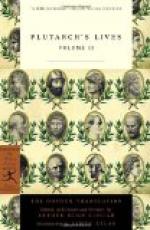[Footnote 266: This phenomenon is mentioned by Strabo (p. 316), Dion Cassius (41, c. 45), and AElian (Various History, 13, c. 16). I do not know if this spot has been examined by any modern traveller. It is a matter of some interest to ascertain how long a phenomenon of this kind has lasted. The pitch-springs of Zante (Zakynthus), which Herodotus visited and describes (iv. 195), still produce the native pitch. Strabo, who had not seen the Nymphaeum, describes it thus after the account of Poseidonius: “In the territory of Apollonia is a place called the Nymphaeum; it is a rock which sends forth fire, and at the base of it are springs of warm asphaltus, the asphaltic earth, as it appears, being in a state of combustion: and there is a mine of it near on a hill. Whatever is cut out, is filled up again in course of time, as the earth which is thrown into the excavations changes into asphaltus, as Poseidonius says.” We cannot conclude from this confused description what the real nature of the phenomenon was. Probably the asphaltus or bitumen was occasionally set on fire by the neighbouring people. (See the art. “Asphaltum,” Penny Cyclopaedia.)]
[Footnote 267: The Cohors was the tenth part of a Roman Legion. Appian (Civil Wars, i. 82) says that on this occasion the opponents of Sulla made their cohorts contain 500 men each, so that a legion would contain 5000 men. According to this estimate there were 90,000 men under arms in Italy to oppose Sulla, who had five legions of Italian soldiers, six thousand cavalry and some men from Peloponnesus and Macedonia; in all forty thousand men. (Appian, Civil Wars, i. 79.) Appian says that he had 1,600 ships.]
[Footnote 268: This passage is explained by the cut p. 287 in Smith’s Dict. of Antiquities, art. “Corona.”]
[Footnote 269: Caius Junius Norbanus and L. Cornelius Scipio Asiaticus were now consuls B.C. 83.]
[Footnote 270: Silvium is a town in Apulia on the Appian road, on the Apennines. As to the burning of the Capitol, see Appian, Civil Wars, i. 86.]
[Footnote 271: Fidentia was in North Italy not far from Placentia (Piacenza): it is now Borgo San Donnino. Appian (Civil Wars, i. 92) speaks of this battle near Placentia, which Lucullus gained over some of Carbo’s troops, not over Carbo himself, as is stated by some modern writers. Carbo was now in Central Italy.]
[Footnote 272: Sulla, with Metellus Pius, who had joined him (Appian, Civil Wars, i. 80), met L. Scipio near Teanum in Campania. Sertorius was with Scipio. The circumstances are told by Appian (Civil Wars, i. 86) as usual with more minuteness and very clearly. The main story is correct in Plutarch.]
[Footnote 273: Signia, now Segni, is in the Volscian mountains, 35 miles south-east of Rome. It was a Roman colony as old us the reign of Tarquinius Superbus, according to Livius (1, 55). This battle was fought B.C. 82, when Cn. Papinus Carbo was consul for the third time with the younger Marius. It appears that Sulla’s progress towards Rome was not very rapid. Appian (Civil Wars, i. 87) places the battle at Sacriportus, the situation of which is unknown.]




